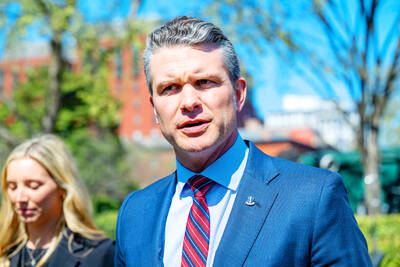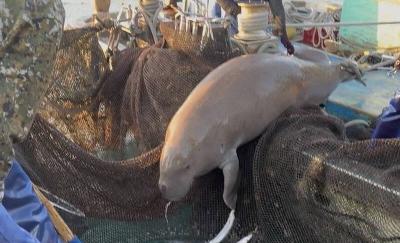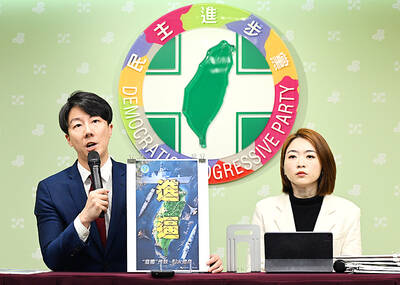Pollutant particles from China may be arriving in Kinmen Island every winter with the northeast seasonal cold front, bringing carcinogenic heavy metals to the traditionally clean outlying island and increasing long-term cancer risks for its residents tenfold, Academia Sinica’s Research Center for Environmental Changes (RCEC) said yesterday.
“Air particulate matter [PM] concentration on the island during the winter months — from September to May — has in recent years been on the rise. Many times a year, PM10 [fine particles in the air smaller than 10 micrometers in size] concentrations reach an alarming 100 or even 150 micrograms per cubic meter,” said RCEC assistant research fellow Hsu Shih-chieh (??, citing statistics collected by the Environmental Protection Administration (EPA).
Hsu said the increase in pollutants in the winter suggested that much of it had been carried to Kinmen from afar by seasonal cold fronts, which do not blow during the summer and fall months.
More alarming is that among the PM10 particles, more than 50 percent are PM2.5 particles, which are more easily inhaled by the human body and therefore cause more damage, he said.
“The WHO advises that a 24-hour average concentration for PM2.5 should not exceed 25μm/m³, or people begin to develop heart, lung and reproductive problems, or even cancer,” Hsu said. “However, the EPA’s data suggests that Kinmen’s PM2.5 concentrations sometimes are more than double the recommended level, at between 50μm/m³ and 75μm/m³.”
Because of the problem, the National Science Council commissioned Hsu’s team to find out what types of pollutants the air particles contain, as well as where they may have come from, Hsu said.
“Since November in 2007, we have been collecting air samples at Kinmen’s Jinning Elementary and Junior High School. We found that the ratio of PM2.5 to PM2.5 to PM10 is 62 to 38 in the winter in Kinmen and the main composition of the particles includes sulfates, nitrates and heavy metals,” he said.
From a match of iron to aluminum ratio between the air samples and air samples in surrounding regions, Hsu’s team also found that the pollutants possibly came from Jinjiang (晉江), a town in China’s Fujian Province known for its pottery industry.
“Besides the resulting powder from pottery manufacturing, because many of the factories burn bad-grade coal in the process, massive amounts of sulfur dioxide and carcinogenic heavy metals — such as arsenic — are emitted,” Hsu said.
With arsenic concentrations at 28 nanograms per cubic meter, RCEC associate research fellow Candice Lung (龍世俊) said: “We were very surprised that Kinmen — a place most people consider unpolluted — would have arsenic concentrations three times that of Taipei.”
With a 70-year long-term exposure to the particles, a person living in Kinmen would have a 10-fold increase in their chances of developing lung cancer, Lung said.
As for the future, both Hsu and Lung said the next step would be to work with academics across the strait to address the situation.
“Pollutants know no borders, this is a regional problem and one that affects the health of people on both sides of the Taiwan Strait,” Hsu said.

‘DENIAL DEFENSE’: The US would increase its military presence with uncrewed ships, and submarines, while boosting defense in the Indo-Pacific, a Pete Hegseth memo said The US is reorienting its military strategy to focus primarily on deterring a potential Chinese invasion of Taiwan, a memo signed by US Secretary of Defense Pete Hegseth showed. The memo also called on Taiwan to increase its defense spending. The document, known as the “Interim National Defense Strategic Guidance,” was distributed this month and detailed the national defense plans of US President Donald Trump’s administration, an article in the Washington Post said on Saturday. It outlines how the US can prepare for a potential war with China and defend itself from threats in the “near abroad,” including Greenland and the Panama

A wild live dugong was found in Taiwan for the first time in 88 years, after it was accidentally caught by a fisher’s net on Tuesday in Yilan County’s Fenniaolin (粉鳥林). This is the first sighting of the species in Taiwan since 1937, having already been considered “extinct” in the country and considered as “vulnerable” by the International Union for Conservation of Nature. A fisher surnamed Chen (陳) went to Fenniaolin to collect the fish in his netting, but instead caught a 3m long, 500kg dugong. The fisher released the animal back into the wild, not realizing it was an endangered species at

The High Prosecutors’ Office yesterday withdrew an appeal against the acquittal of a former bank manager 22 years after his death, marking Taiwan’s first instance of prosecutors rendering posthumous justice to a wrongfully convicted defendant. Chu Ching-en (諸慶恩) — formerly a manager at the Taipei branch of BNP Paribas — was in 1999 accused by Weng Mao-chung (翁茂鍾), then-president of Chia Her Industrial Co, of forging a request for a fixed deposit of US$10 million by I-Hwa Industrial Co, a subsidiary of Chia Her, which was used as collateral. Chu was ruled not guilty in the first trial, but was found guilty

The Chinese Nationalist Party (KMT) is maintaining close ties with Beijing, the Democratic Progressive Party (DPP) said yesterday, hours after a new round of Chinese military drills in the Taiwan Strait began. Political parties in a democracy have a responsibility to be loyal to the nation and defend its sovereignty, DPP spokesman Justin Wu (吳崢) told a news conference in Taipei. His comments came hours after Beijing announced via Chinese state media that the Chinese People’s Liberation Army’s Eastern Theater Command was holding large-scale drills simulating a multi-pronged attack on Taiwan. Contrary to the KMT’s claims that it is staunchly anti-communist, KMT Deputy